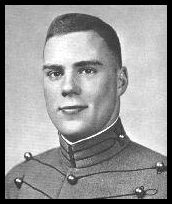 |
MEMORIAL ARTICLE
Published Assembly Pending
ROBERT EARL WAYNE - '46
NO. 15675 * 18 Dec 1925 - 21 Sep 1998
Died in Houston, TX - Interred West Point Cemetery, West Point,
NY |
Robert Earl Wayne was one of those rare individuals
whose element was aerial combat. He reveled in it for the excitement
and the competition. Early in his life this love of excitement
and competition was provided by sports. Born in the Bronx, New
York, Bob grew up in Garden City, Nassau, New York. He was a
star football and baseball player at Hempstead High School, Hempstead,
NY where he graduated in 1942. After a year at Braden's Prep
at Cornwall on Hudson, Bob joined the Class of 1946 at West Point
on 1 July 1943.
Bob's sports endeavors continued as a cadet. He
was the tight end on the Army football team and was a member
of the 1945 National Championship team. He also was goalie on
the Army hockey team. In April of yearling year, Bob made the
choice that was to lead him into the career that would provide
the environment in which he excelled. He opted for Air Cadet
Training. This culminated in his receiving his wings and the
gold bars of a second lieutenant in the Army Air Corps at graduation.
After transition training for fighters, Bob was
assigned to Japan in 1949. When the Korean War started in June
1950, Bob began what was to be a distinguished career as a fighter
pilot where he excelled in times of peace and during four combat
tours in Korea and Vietnam.
Bob flew on the first combat mission of the Korean
War on 26 June 1950 and finished his tour with more than 100
combat missions. Early in his tour, he was in a flight of four
F-80 aircraft which encountered and destroyed four enemy IL-10
Stormovik fighters. Bob personally destroyed two enemy planes.
Later in his tour, he was shot down behind enemy lines and became
the first US Air Force pilot rescued by helicopter. At the end
of his combat tour, he was awarded two Distinguished Flying Crosses,
11 Air Medals and the Purple Heart Medal.
In Vietnam, on his first tour, Bob commanded the
357th Tactical Fighter Squadron and flew 100 combat missions
over North Vietnam in F-105s.
Bob's second combat tour saw him serving as Deputy
Commander for Operations and then Vice Commander of the 355th
Tactical Fighter Wing.
In between combat tours, Bob served in various
staff positions in the Joint Chiefs of Staff (JCS), Headquarters
Tactical Air Command and served as Commander of the Second Aircraft
Delivery Group prior to retirement.
He returned to Southeast Asia for a third combat
tour and was serving with Task Force Alpha when he was selected
as Wing Commander of the 56th Special Operations Wing. He flew
combat missions in the F-4 and OV-10 aircraft over North Vietnam,
Laos and Cambodia until the war ended. During his three combat
tours in SE Asia, Bob's combat leadership, courage and superb
flying ability earned him three Silver Star Medals, five Distinguished
Flying Crosses and 26 Air Medals.
During this tour, General John Ryan, AF Chief of
Staff, directed a post mission, face-to-face critique of each
strike package over North Vietnam be conducted and a priority
report of lessons learned, with recommendations for improvement,
be submitted to him. Bob was designated to conduct these sessions
and produce each report. His personal participation in many of
the missions and his extensive knowledge and background in fighter
aviation served him well and resulted in improved bombing effectiveness,
better inter-force coordination and safety of friendly forces.
Bob retired in 1976 as a Colonel.
Bob's civilian employment began with TRW where
he was a consultant for the Shah of Iran's fighter program. Upon
completion of this job, he joined Flight Safety International
(FSI). He began as Manager of the Cessna Citation Division in
Wichita, KS and was later transferred to Houston, TX as the FSI
Branch Manager. He loved to play golf and excelled as in all
other sports. The only thing that would cause him to miss a golf
date was a job as pilot for hire, which he did on a regular basis
until his passing. He often said, "When I go, I want to
be in a cockpit or on the golf course." Bob collapsed on
a golf course in Houston during a golf tournament 21 September
1998 and later died in a Houston hospital.
Survivors include his wife, Dwala, and from a previous
marriage, son, Robert and daughters, Suzy, Penny and Polly and
seven grandchildren.
Bob Wayne lived the life in combat that many envied.
He was the consummate combat fighter pilot. All his years competing
in sports had honed him to meet this challenge, not only meet,
but to excel. Classmate and fellow airman, LTG James D. Hughes,
USAF, Rtd, best sums up Bob Wayne: "Bob Wayne's contemporaries
have long recognized him as a truly accomplished military aviator
of great courage, aggressiveness, dedication and skill. He was
a 'fighter pilot's fighter pilot' and the Air Force and the nation
are much the better for his many years of service."
The Class of 1946 is proud to proclaim for our
gallant classmate: "Well Done, Bob; Be Thou At Peace!"
'46 Memorial Article Project and his family
|